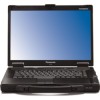Panasonic Toughbook 52 Mapping Technical and Operational Challenges of Mobile - Page 3
depreciation charged for capital expenditures, as well as salaries and benefits. Soft
 |
View all Panasonic Toughbook 52 manuals
Add to My Manuals
Save this manual to your list of manuals |
Page 3 highlights
To determine "true" TCO, it is imperative to consult both hard (direct) and soft (indirect) costs. Hard costs consist of hardware and software costs, including depreciation charged for capital expenditures, as well as salaries and benefits. Soft costs are more difficult to determine and include expenses associated with operating and maintaining any mobile solution. Downtime costs, including any productivity loss and lost revenue streams, factor in here. VDC's research shows that over 70% of the cost of owning a mobility solution can come after the initial purchase. This underscores the significance of taking a long term view during the initial selection process. Figure A Total Cost of Ownership Understanding soft costs and being able to marry the best possible mobile computer with the target user and application is ultimately what will set apart mobility innovators and enable companies to fully leverage mobility investments as a true competitive advantage. Understanding soft costs and being able to marry the best possible mobile computer with the target user and application is ultimately what will set apart mobility innovators and enable companies to fully leverage mobility investments as a true competitive advantage. However, organizations looking to cut expenditures will frequently opt for lower cost mobile computing hardware. In many cases this means the use of a nonrugged mobile computer for applications that are better served by rugged devices. The subsequent high frequency of hardware failures in many of these deployments, many supporting mission-critical applications, significantly impacts operational effectiveness. According to VDC's most recent research, annual mobile computer failure rates exceeding 30% are not uncommon. © 2009 VDC Research Group, Inc. 2












